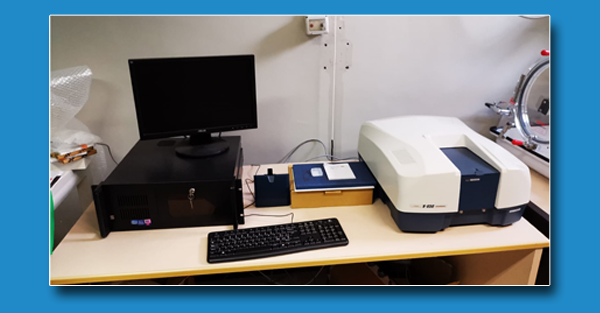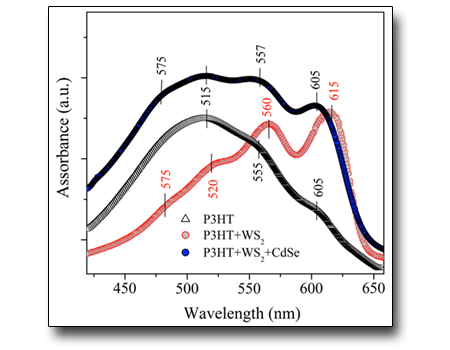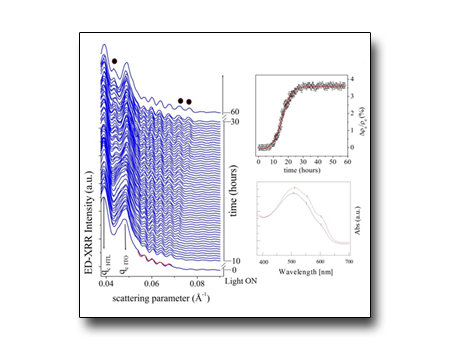
UV-Vis Jasco V630 double beam spectrometer
Barbara Paci -
TECHNICAL SPECIFICATIONS
- Optical system: Single monochromator-UV/VIS region 1200lines/mm-double beam light
- Light source: Deuterium lamp (190-350nm)-Halogen lamp (330-1100nm)
- Detector: Silicon photodiode
- Wavelength repeatability: ±0.1nm
- Slow spead:12000nm/min
- Spectral bandwidth: 1.5nm fixed
- Photometric accuracy: ± 0.002 Abs (0 to 0.5 Abs); ± 0.003 Abs (0.5 to 1 Abs); ± 0.3% T
- Photometric repeatability: ± 0.001 Abs (0 to 0.5 Abs); ± 0.001 Abs (0.5 to 1 Abs)
- Accessory to perform thin film measurements at variable incidents degrees
AVAILABLE TECHNIQUES
-
Single beam acquisition from cuvette (no automatic base line subtraction)
-
Single beam acquisition from thin film (no automatic base line subtraction)
-
Double beam acquisition from cuvette (automatic subtraction of the “white” baseline)
-
Double beam acquisition from films (automatic subtraction of the “white” baseline)
SAMPLES
-
Liquid samples in standard Uv-Vis cuvettes
-
Thin film samples: max. in plane dimensions 2cm*2cm
USE FOR
-
UV / Visible spectroscopy is used in the field of a chemistry /physics as a complementary technique, for the quantitative determination of many analytes including transition metal ions, conjugated compounds and biological macromolecules. Among the many applications of this technique are:
1) Detection of impurities
2) Search for chromophores
3) Quantitative analysis
CASE STUDIES
Structural morphological and optical properties of P3HT/CdSe/WS2 ternary composites for hybridorganic/inorganic photovoltaics
The development of complete organic/inorganic hybrid solar cells (HOSCs) is strictly related to the achievement of appealing electrical performances. In this context, the optimization of device architectures and of the active material’s structural and morphological properties is crucial. In this work, such highly critical issues are addressed for a novel hybrid nanocomposite: tungsten disulfide nanotubes (WS2 NTs)and cadmium selenide quantum dots (CdSe QDs) embedded into a Poly (3-hexylthiophene-2,5-diyl) (P3HT) polymericmatrix. Both binary and ternary compounds are produced and investigated by means of an unconventional energy-dispersive X-ray diffraction technique combined with atomic force microscopy and Raman spectroscopy. Additionally, the effects of low-temperature thermal treatments on the nanocomposite’s structure and morphology are disclosed, unraveling their connection of these features to the optical response of the materials, investigated by UV–Vis spectroscopy. Promising results are obtained in terms of enhanced crystallinity, phase separation, and the possibility of decorating the WS2 NTs with CdSe dots is demonstrated, opening new perspectives for further development of complete HOSCs based on this innovative ternary system.
Si veda: A. Generosi, et al. J Mater Sci (2017) 52:9573–9583


Organic solar cells are very promising systems for developing green, low cost and flexible solar energy conversion devices. Despite the efficiencies are now appealing (over 17%) the technological transfer is still limited by the low durability. Several processes, in bulk and at interface, are responsible. The quick downgrading of the performance is due to a combination of physical and chemical degradations. These phenomena induce instability and a drop of performances in working conditions. Close monitoring of these processes is mandatory to understand the degradation pathways upon device operation. Here an unconventional approach based on in-situ Energy Dispersive X-ray Reflectivity is used, together with AFM and UV-Vis spectroscopy, to address the role of Wells-Dawson polyoxometalate ((K6-P2W18O62 -hereafter K6-P2W18), as hole transporting layer in organic photovoltaics. The results demonstrate that K6-P2W18 thin films, showing ideal bulk and interface properties and superior optical/morphological stability upon prolonged illumination, are attractive candidates for the interface of durable OPV devices.
Si veda: A. Generosi et al. In Press Symmetry

 English (UK)
English (UK)  Italiano (Italia)
Italiano (Italia)